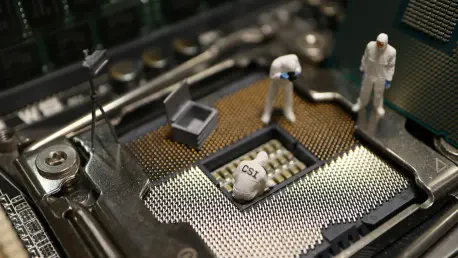In an era where digital connectivity underpins nearly every facet of modern life, the integration of artificial intelligence into networking systems stands as a groundbreaking shift, promising unprecedented speed and reliability. Imagine a global enterprise struggling with inconsistent network performance due to a patchwork of solutions cobbled together over decades, only to find that AI could streamline operations—if implemented with exacting precision. This scenario is not hypothetical but a real challenge facing countless organizations today. The push for AI-driven networking isn’t just about adopting cutting-edge technology; it’s about addressing the fundamental flaws of fragmented systems that have long hindered efficiency. As industries from education to corporate sectors demand seamless connectivity, the need for a unified, precise approach over disjointed fixes becomes undeniable. This discussion explores how AI is reshaping networking, emphasizing why precision trumps patchwork in meeting today’s complex demands.
The Evolution of Networking Challenges
Addressing Fragmentation in Traditional Systems
The networking landscape has long been characterized by a patchwork of solutions, assembled over time from multiple vendors with little regard for cohesive integration. These systems, often built on disparate hardware and software, struggle to deliver the consistency required in a world increasingly reliant on digital infrastructure. The result is a tangle of inefficiencies—think of delayed data transfers or inconsistent security protocols—that can cripple operations for businesses and institutions alike. AI-driven networking offers a potential remedy, but only if it moves beyond the ad-hoc fixes of the past. A full-stack approach, where every component from hardware to applications is designed with compatibility in mind, emerges as a critical necessity. Without this, the promise of AI risks being undermined by the very fragmentation it seeks to overcome, leaving organizations grappling with the same old bottlenecks in a new technological guise.
The High Stakes of Inconsistent Performance
Beyond mere inconvenience, the stakes of maintaining fragmented networking systems are alarmingly high in environments where reliability is non-negotiable. Consider sectors like healthcare or finance, where a single network glitch could disrupt critical services or compromise sensitive data. Traditional setups, lacking unified control, often fail to provide the deterministic outcomes that AI demands for optimal performance. This inconsistency isn’t just a technical annoyance; it translates into real-world consequences, from lost revenue to compromised safety. The shift toward AI-driven solutions must therefore prioritize precision, ensuring that every layer of the network operates in harmony. Only through such meticulous design can the technology deliver on its potential to transform connectivity, turning what was once a liability into a strategic asset for organizations navigating an increasingly complex digital landscape.
Building the Future with AI-Driven Precision
Redefining Control Through a Unified Stack
One of the most compelling arguments for precision in AI-driven networking lies in the adoption of a full-stack approach, where every element of the system is engineered for seamless interaction. Unlike the patchwork systems of old, this method involves designing hardware platforms, firmware, operating systems, and data pipelines as a single, cohesive unit. Such integration allows for unprecedented control, enabling AI to optimize performance with accuracy that fragmented setups simply cannot match. Companies leading this charge are setting a new standard, demonstrating that a unified stack isn’t just an ideal but a practical solution to the chaos of multi-vendor environments. This approach ensures that AI can predict and address network issues before they escalate, providing a level of reliability that modern users—whether global enterprises or small schools—desperately need in their daily operations.
Prioritizing Accuracy Over Creative Experimentation
In contrast to AI applications in fields like content creation, where creativity often takes center stage, networking demands a focus on deterministic outcomes and precision. The technology must ensure that data flows reliably and securely, without the variability that might be acceptable in less critical contexts. This means training AI models with in-house data rather than relying on external providers, a strategy that enhances both control and security. By keeping sensitive information within a closed loop, organizations can mitigate risks associated with privacy breaches while maintaining the high standards of performance that networking requires. This emphasis on accuracy over experimentation underscores a broader truth: AI in this domain isn’t about pushing boundaries of imagination but about delivering consistent, predictable results that users can depend on, day in and day out.
Overcoming Resource Barriers for Scalability
Implementing AI-driven networking at scale presents another formidable challenge: the immense computational resources required to train and refine models. Access to high-powered infrastructure, such as advanced GPU clusters, often separates genuine innovators from those merely paying lip service to AI integration. The financial and technical barriers are significant, as continuous iteration and testing demand both expertise and investment that many vendors lack. This reality serves as a litmus test for credibility within the industry, highlighting the gap between marketing claims and tangible results. For AI to truly revolutionize networking, organizations must commit to securing the necessary resources, ensuring that precision isn’t sacrificed for expediency. Only with such dedication can the technology scale to meet the diverse needs of users across sectors, from sprawling corporate networks to resource-constrained educational institutions.
Reflecting on a Transformative Shift
Lessons from a Precision-Driven Approach
Looking back, the journey toward AI-driven networking revealed a stark contrast between the fragmented systems that once defined the industry and the unified, precise solutions that emerged as necessities. The recognition that patchwork approaches could no longer support the demands of modern connectivity marked a turning point, driving innovation in full-stack design. Companies that embraced this shift demonstrated how control at every level—from hardware to data handling—could transform performance, delivering reliability where inconsistency once reigned. This evolution underscored a vital lesson: precision wasn’t merely a preference but a prerequisite for harnessing AI’s potential in networking, ensuring that technology served as a bridge rather than a barrier to progress.
Charting the Path Forward with Strategic Investments
As the industry reflected on these advancements, the focus shifted to actionable steps for sustaining momentum. Prioritizing investments in computational infrastructure stood out as a critical next move, ensuring that the resources needed for AI model training were accessible to innovators. Equally important was the commitment to data security, maintaining in-house control to safeguard user trust. Moving forward, stakeholders needed to foster collaboration across sectors, sharing insights to refine precision-driven approaches. By building on the foundation laid by early adopters, the networking field could continue to evolve, addressing emerging challenges with the same rigor that defined this transformative era. This strategic vision promised a future where AI didn’t just enhance connectivity but redefined it for generations to come.









